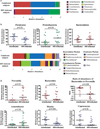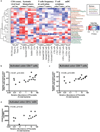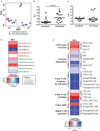An altered intestinal mucosal microbiome in HIV-1 infection is associated with mucosal and systemic immune activation and endotoxemia
- PMID: 24399150
- PMCID: PMC4062575
- DOI: 10.1038/mi.2013.116
An altered intestinal mucosal microbiome in HIV-1 infection is associated with mucosal and systemic immune activation and endotoxemia
Abstract
Human immunodeficiency virus-1 (HIV-1) infection disrupts the intestinal immune system, leading to microbial translocation and systemic immune activation. We investigated the impact of HIV-1 infection on the intestinal microbiome and its association with mucosal T-cell and dendritic cell (DC) frequency and activation, as well as with levels of systemic T-cell activation, inflammation, and microbial translocation. Bacterial 16S ribosomal DNA sequencing was performed on colon biopsies and fecal samples from subjects with chronic, untreated HIV-1 infection and uninfected control subjects. Colon biopsies of HIV-1-infected subjects had increased abundances of Proteobacteria and decreased abundances of Firmicutes compared with uninfected donors. Furthermore at the genus level, a significant increase in Prevotella and decrease in Bacteroides was observed in HIV-1-infected subjects, indicating a disruption in the Bacteroidetes bacterial community structure. This HIV-1-associated increase in Prevotella abundance was associated with increased numbers of activated colonic T cells and myeloid DCs. Principal coordinates analysis demonstrated an HIV-1-related change in the microbiome that was associated with increased mucosal cellular immune activation, microbial translocation, and blood T-cell activation. These observations suggest that an important relationship exists between altered mucosal bacterial communities and intestinal inflammation during chronic HIV-1 infection.
Conflict of interest statement
Figures




References
-
- Kotler DP, Gaetz HP, Lange M, Klein EB, Holt PR. Enteropathy associated with the acquired immunodeficiency syndrome. Annals of internal medicine. 1984;101:421–428. - PubMed
-
- Epple HJ, et al. Acute HIV infection induces mucosal infiltration with CD4+ and CD8+ T cells, epithelial apoptosis, and a mucosal barrier defect. Gastroenterology. 2010;139:1289–1300. - PubMed
Publication types
MeSH terms
Grants and funding
LinkOut - more resources
Full Text Sources
Other Literature Sources
Medical

